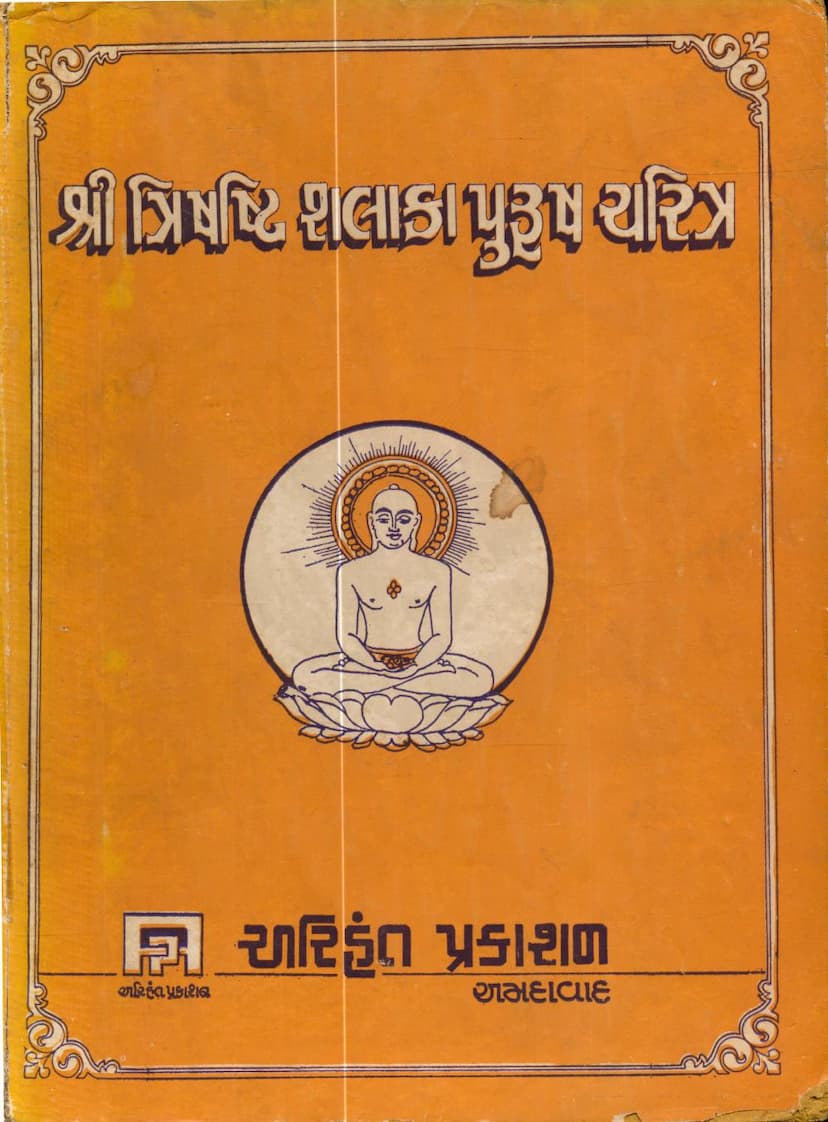Trishashti Shalaka Purush Charitra Part 03
Added to library: September 2, 2025

Summary
This comprehensive summary of Trishashti Shalaka Purush Charitra Part 03 provides a detailed overview of the Jain text, as requested.
Book Title: Trishashti Shalaka Purush Charitra Part 03 Author(s): Jain Dharm Prasarak Sabha (translated from Acharya Shri Hemchandracharya's Sanskrit work) Publisher: Arihant Prakashan, Ahmedabad Catalog Link: https://jainqq.org/explore/032706/1
Overall Purpose:
This volume, part of a larger series, presents the biographies of 63 illustrious figures known as Shalaka Purushas (precious men) in Jain tradition. These figures are considered exemplars whose lives and actions are profoundly influential for spiritual progress and understanding the Jain path to liberation. This specific volume focuses on the lives of:
- Shri Rishabhdevji (Adishwarji) and Bharat Chakravarti
- Shri Ajitnathji and Sagar Chakravarti
Key Themes and Content:
The provided text is the Gujarati translation of Acharya Shri Hemchandracharya's Sanskrit work. It aims to make the profound teachings and historical narratives of Jainism accessible to a wider audience through its compelling storytelling. The work emphasizes the following:
-
The Importance of Faith over Intellect Alone: The preface (Page Saga #4) strongly argues against the modern tendency to dismiss religious texts and figures as "myths" or mere poetic imagination. It advocates for the power of shraddha (faith) in understanding realities that transcend empirical perception and time. It contrasts rigid intellectualism (buddhivada) with faith-driven wisdom (buddhinishtha) as the foundation of true scientific understanding and cultural preservation.
-
The Trisahasti Shalakapurusha: The text defines Shalaka Purushas as the 63 supreme beings in each time cycle, whose lives are marked by significant spiritual and worldly achievements. The title itself, Trishashti Shalakapurush Charitra, signifies the exhaustive account of these 63 great souls.
-
Structure of the Text: The entire work is divided into ten Parvas (sections), and this volume covers sections related to the lives of Shri Rishabhdevji, Bharat Chakravarti, Shri Ajitnathji, and Sagar Chakravarti. The preface (Page Saga #10) provides a detailed breakdown of the 63 Shalaka Purushas included in each of the ten Parvas, illustrating the meticulous structure of Acharya Hemchandracharya's magnum opus.
-
Biographical Narratives: The core of the text comprises detailed life stories of the Shalaka Purushas.
- Shri Rishabhdevji (Adishwarji): The first Tirthankara, whose life is presented as the origin of Jain teachings, the establishment of societal structures, and the ultimate attainment of liberation. His story is foundational, setting the stage for the subsequent lives.
- Bharat Chakravarti: The eldest son of Shri Rishabhdevji, who became a Chakravarti (universal monarch). His life showcases the potential for worldly power and the eventual renunciation of it for spiritual realization, a common theme among Shalaka Purushas.
- Shri Ajitnathji: The second Tirthankara, whose life narrative is presented, highlighting his spiritual journey and accomplishments.
- Sagar Chakravarti: Another powerful monarch whose life is depicted, likely focusing on his worldly reign and eventual spiritual turning point.
-
Spiritual and Ethical Teachings: Embedded within the biographical narratives are profound Jain principles and ethical guidelines. The lives of these Shalaka Purushas serve as examples of virtues like non-violence (ahimsa), truthfulness (satya), non-possessiveness (aparigraha), self-control (brahmacharya), and the pursuit of knowledge and spiritual discipline.
-
Literary Merit: The text is praised for its extensive scope, detailed descriptions (including battles, city descriptions, and festivals), and the author's intellectual prowess, vast memory, and analytical skills. The preface (Page Saga #10) notes the captivating nature of the narratives, making them accessible and engaging for all readers, regardless of their intellectual background. The inclusion of Gujarati translations enhances its reach.
-
Relevance and Revival: The publication of this new edition is presented as a vital effort to counteract the decline of religious and cultural values in the modern era and to reaffirm the historical reality and spiritual significance of these great souls. The publishers, Shri Jain Dharm Prasarak Sabha, are commended for making this valuable work available again to satisfy the public's hunger for sad-vachan (virtuous reading).
Specific Content Highlighted:
- Page 3 (Saga #3): Features a Yantra (diagram) illustrating the distribution of the Shalaka Purushas across different categories (Tirthankara, Chakravarti, Vasudeva, Baladeva, Prativuasudeva, Prativaseudeva) across the ten Parvas. This highlights the systematic and comprehensive nature of the work.
- Page 4 (Saga #4): The detailed introduction discusses the importance of history, great men, and scriptures in shaping a culture. It criticizes the Western notion of "myth" applied to religious narratives and emphasizes the power of faith in understanding these truths.
- Page 10 (Saga #10): The preface provides a detailed outline of the ten Parvas and the number of Shalaka Purushas covered in each, reinforcing the text's encyclopedic nature.
- Page 11 (Saga #11): Explains the meaning of "Shalaka Purusha" as those whose attainment of liberation is certain and discusses the karmic trajectories of different types of Shalaka Purushas.
- Page 12 (Saga #12): Introduces the seventh Parva and mentions its Jain Ramayana aspect, focusing on the characters of Ramachandra, Lakshman, Sita, Ravana, etc., as described in the Jain tradition.
- Page 16-28 (Sagas #16-28): These pages detail the specific chapters (Sargas) within the seventh Parva, particularly focusing on the lives of Rama, Lakshmana, Hanuman, and the intricate narrative of Ravana's lineage and rise. This section is particularly rich in mythological and epic detail as interpreted through the Jain lens.
In essence, this volume of Trishashti Shalakapurusha Charitra is a foundational text in Jainism, meticulously detailing the lives of key spiritual and worldly figures to provide moral instruction, historical context, and a deep understanding of the Jain path to salvation, while strongly advocating for the preservation of faith and cultural heritage.